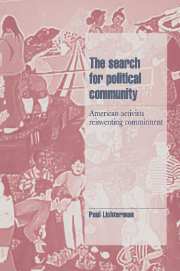Book contents
- Frontmatter
- Contents
- Acknowledgments
- 1 Personalism and political commitment
- 2 Personalized politics: the case of the US Greens
- 3 Speaking out in suburbia
- 4 Imagining community, organizing community
- 5 Culture, class, and life-ways of activism
- 6 Personalized politics and cultural radicalism since the 1960s
- 7 The search for political community
- Appendix I Choosing and studying the organizations
- Appendix II Why participant-observation was necessary
- Notes
- References
- Index
3 - Speaking out in suburbia
Published online by Cambridge University Press: 23 January 2010
- Frontmatter
- Contents
- Acknowledgments
- 1 Personalism and political commitment
- 2 Personalized politics: the case of the US Greens
- 3 Speaking out in suburbia
- 4 Imagining community, organizing community
- 5 Culture, class, and life-ways of activism
- 6 Personalized politics and cultural radicalism since the 1960s
- 7 The search for political community
- Appendix I Choosing and studying the organizations
- Appendix II Why participant-observation was necessary
- Notes
- References
- Index
Summary
TAKING RISKS
The Greens put on public education campaigns and attended demonstrations without worrying about whether they were sullying their reputations as respectable citizens. Going public was not nearly so easy for members of Airdale Citizens for Environmental Sanity (ACES). ACES had dedicated itself to sparking a critical public debate about environmental safety at a local firm, Microtechnologies Ltd. (“Microtech,” or ML). The firm was a frequent military contractor, and secured a number of contracts for work related to upgrading US weapons systems. Work at Microtech resulted in highly toxic wastes, some of which had seeped into local groundwater, and the firm proposed to build an incinerator for disposing of them. A group of roughly six core members of the Airdale Citizens for Environmental Sanity (ACES) started a campaign to alert Airdale about the hazards of burning the wastes in the proposed incinerator. Most of Airdale did not care to listen, let alone debate the issue.
For ACES members, going public meant braving the withering stare of public opinion in Airdale, a small town of suburban-style neighborhoods about an hour's drive north of Ridgeville. The activists liked to tell newcomers the story of how someone at a public hearing on the incinerator had remarked, “There goes that crazy lady again,” as the group's leading spokesperson, Laura, walked up to the microphone. Laura's son feared Laura would get arrested for her activism, leading to embarrassing consequences for him: “I have to go to school in this town.” Other members thought they had paid with their local reputations for their association with ACES.
- Type
- Chapter
- Information
- The Search for Political CommunityAmerican Activists Reinventing Commitment, pp. 71 - 104Publisher: Cambridge University PressPrint publication year: 1996

